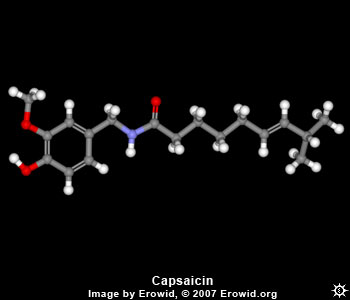by Erowid
| NAME : | Capsaicin |
| CHEMICAL NAME : | trans-8-methyl-N-vanillyl-6-nonenamide |
| ALTERNATE CHEMICAL NAMES : |
(E)-N-[(4-Hydroxy-3-methyoxyphenyl)-methyl]-8-methyl-6-nonenamide; N-(4-hydroxy-3-methoxybenzyl)-8-methylnontrans-6-enamide; |
| CHEMICAL FORMULA | C18H27NO3 |
| MOLECULAR WEIGHT | 305.42 |
| MELTING POINT | 65° C |
| BOILING POINT | 210-220° C |
| From the Merck Index 12th Edition | |
|---|---|

INFORMATION
Compare Capsaicin molecule to another chemical
OFF-SITE LINKS
ScienceLab : Capsaicin Material Safety Data Sheet
MERCK INDEX ENTRY
1811. Capsaicin. (E)-N-[(4-Hydroxy-3-methyoxyphenyl)-methyl]-8-methyl-6-nonenamide; trans-8-methyl-N-vanillyl-6-nonenamide N-(4-hydroxy-3-methoxybenzyl)-8-methylnontrans-6-enamide; Axsain; Mioton; Zostrix. C18H27NO3; mole wt 305.42. C 70.79%, H 8.91%; N 4.59%, O 15.72%. :Pungent principle in fruit of various species of Capsicum, Solanaceae. Isoln from paprika and cayenne: Thresh, Pharm. J. and Trans. 7,21(1876); Micko, Z. Nahr. Genussm. 1, 818 (1898). See Beilstein 13, suppl. I, 322. Early structure study: Nelson, J. Am. Chem. Soc. 43, 597 (1920). Synthesis: Späth, Darling, Ber. 63, 737 (1930); L. Crombie et al., J. Chem. Soc. 1955, 1025; O.P. Vig et al., Indian J. Chem. 17B, 558 (1979). Constitution and biosynthesis: D. J. Bennet, E.W. Kirby, J. Chem. Soc. C 1968, 442. Pharmaoclogy: Molnar et al., Acta Physiol. 35, 369 (1969). Capsaicin is a powerful irritant; initial administration causes intense pain. Prolonged treatment causes insensitivity to painful stimuli and induces selective degeneration of certain primary sensory neurons: G. Jancso et al., Nature 270, 741 (1977); R. Gamse, Arch Pharmacol. 320, 205 (1982); P. Holzer et al., Neurosci. Letters 31, 253 (1982). Neuronal depletion of substance P, q.v.: T.M. Jessell et al., Brain Res. 152, 183 (1978); T.L. Yaksh et al., Science 206, 481 (1979). Capsaicin pretreatment also induces long-lasting desensitization of airway mucosa to various mechanical and chemical irritatns: J.M./ Lundberg, A. Saria, Nature 302, 251 (1983). Preliminary clinical evaluation in chronic postherpetic neuralgia: J.E. Bernstein et al., J. Am. Acad. Dermatol. 17, 93 (1987). Reviews: Molnar, Arzneimittel-Forsch. 15, 718 (1965); Walker, Gavern, Mgf. Chem. Aerosol News 39 (6), 35 (1968); R. M. Virus, G.F. Gebhart, Life Sci. 25, 1273(1979); Y. Monsereenusorn et al., CRC Crit. Rev. Toxicol. 10, 321-339 (1982).
Monoclinic, rectangular plates, scales from petr ether, mp 65°. bp(.01) 210-220° (air-bath temp). uv max: 227, 281 nm (e 7000, 2500). Burning taste, one part in 100,000 can be detected by tasting. Practically insol in cold water. Freely sol in alc, ether, benzene, chloroform; slightly sol in CS2. Use: As a tool in neurobiological research. Therap Cat: Topical Analgesic. Hydrocholoride, C11H15NO2.HCl, crystals from isopopanol/n-hexane, mp 147-148° (Bailey). Crystals from isopropanol/ether, mp 152-153° (Braun). uv max (ethanol): 286 nm (E 2843). LD50 in mice, rats, guinea pigs (mg/gk): 97,49,98 i.p. (Hardman).
Note: This is a controlled substance (hallucinogen) listed in the U.S. Code of Federal Regulations, Title 21 Part 1308.11 (1995).


